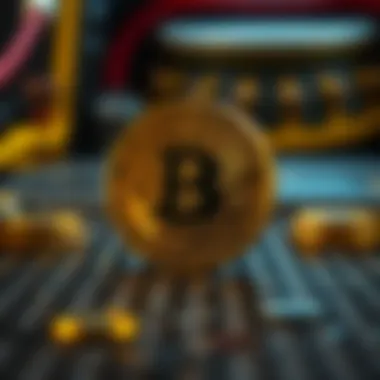Mining NFT Tokens: A Comprehensive Analysis of Trends


Intro
Non-Fungible Tokens (NFTs) have become a massive buzzword in the tech and investment communities. They are unique digital assets representing ownership of items, from artwork to in-game items, meticulously recorded on the blockchain. But amidst the clamor for these digital collectibles, there's a subfield gaining traction—mining NFT tokens. It's a fascinating area intertwining technology, marketplace dynamics, and economic potential.
As NFT popularity skyrockets, understanding the mechanisms behind the mining of these tokens is crucial. NFT mining involves the process of validating and verifying transactions on the blockchain, where artists and creators mint NFTs, turning intangible concepts into tradable, proof-based assets. This section aims to lay the groundwork for a comprehensive examination of the complexity surrounding NFT tokens.
In diving deeply into this subject, we will peel back layers to reveal underlying technologies, dissect economic implications, and highlight the rapidly evolving marketplace. Among the essential points discussed are the fundamental mechanics of NFT creation and various methodologies and strategies employed by participants. Through this exploration, both newbies and seasoned professionals will find worthwhile insights. Let's delve into the market analysis for NFT tokens.
Understanding NFTs
In the burgeoning landscape of digital assets, Non-Fungible Tokens, or NFTs, represent a cornerstone for creators, collectors, and investors alike. Understanding NFTs is not merely an academic exercise; it is a crucial endeavor that underpins the entire framework of NFT mining, trading, and appreciation. As the world becomes increasingly digitized, NFTs have carved out a niche that blends art, technology, and finance, leading to new opportunities and challenges across numerous sectors.
Definition of Non-Fungible Tokens
At its core, a Non-Fungible Token is a unique digital asset verified using blockchain technology, where each token has distinct properties and cannot be exchanged on a one-to-one basis with another token. Unlike cryptocurrencies such as Bitcoin or Ethereum that are fungible, meaning each unit is identical to another, NFTs hold specific identities that confer value based on rarity, ownership, and provenance.
This uniqueness makes NFTs highly desirable in fields like art, music, gaming, and collectibles. For example, an NFT representing a piece of digital art by a renowned artist cannot be simplistically traded for a token representing a different work of art, as their value is not interchangeable. This definition not only highlights their uniqueness but also introduces the importance of provenance in establishing an NFT's value, a consideration that miners and collectors alike must bear in mind.
Comparison with Cryptocurrencies
While both NFTs and cryptocurrencies operate on blockchain technology, they serve different purposes and appeal to different markets. Cryptocurrencies like Bitcoin are predominantly designed as a medium of exchange and store of value. They can be easily traded and are often seen as a form of digital currency.
Conversely, NFTs are catered towards providing ownership rights over specific digital assets. For investors and traders, this means understanding that the value of an NFT may not only hinge on market speculation but also on the artistic or intrinsic value of the asset itself. In a way, understanding this contrast is like comparing apples to oranges: both contribute to the fruits of the digital economy, but they do so in fundamentally different manners.
Key Differences:
- Fungibility: Cryptocurrencies are interchangeable; NFTs are unique.
- Purpose: Cryptos act as currency; NFTs signify ownership of singular items.
- Market Dynamics: Cryptocurrencies are influenced by trading volume and market sentiment; NFTs are impacted by cultural and community elements.
The Unique Value Proposition
The true allure of NFTs lies in their unique value proposition. They not only empower creators by allowing direct monetization of their work but also grant buyers a level of ownership and engagement previously unavailable in the digital landscape. When you buy an NFT, you are not just purchasing a piece of art or a collectible – you are gaining an asset that holds the potential for appreciation in value tied to its cultural significance and rarity.
Additionally, NFTs nurture a symbiotic relationship between creators and collectors. Artists can receive royalties automatically through smart contracts each time their NFT is resold, further incentivizing the creation of high-quality content.
“NFTs are reshaping the way we think about ownership in the digital world, providing a platform for creators to flourish and collectors to engage like never before.”
The Mining Process
The process of mining NFT tokens is crucial in understanding how the entire ecosystem operates. It serves as a bridge between the conceptualization of NFTs and their actualization on a blockchain. Mining not only encapsulates the technical aspects of creating NFTs but also encompasses the broader economic and social dynamics at play. By shedding light on this topic, we can comprehend the significance of the technologies involved, the motivations behind participation, and the implications for investors and creators alike.
How NFT Tokens Are Created
NFT tokens are birthed through a diverse range of processes involving unique components such as blockchain networks, smart contracts, and digital assets. Essentially, NFTs are digital certificates of ownership that associate a unique identifier with a specific asset. Here's how it all unfolds:
- Digital Asset Selection: The journey begins with a digital asset, which could be anything from digital art to music files, collectibles, or even virtual real estate. It's fundamental that this asset possesses verifiable uniqueness, allowing it to be distinguishable in the digital realm.
- Choosing a Blockchain: Not all blockchains are created equal, and selecting the right one is paramount. Ethereum, for instance, is a favorite due to its robust smart contract capability. However, alternatives like Binance Smart Chain and Flow are emerging contenders in this sphere.
- Minting Process: This is where the actual creation happens. Using a smart contract, the digital asset is minted into an NFT. The smart contract will dictate the rules of ownership, transfer, and any royalties that may apply. This step is critical as it also ensures the asset’s integrity in terms of provenance.
- Storage and Distribution: After minting, the NFT is stored on the blockchain, making it publicly accessible and verifiable. Anyone can track its ownership history, which adds layers of trust and transparency.
Ultimately, the creation of NFT tokens is a synthesis of technology, creativity, and market dynamics, making it a vital area of focus within the NFT mining narrative.
Necessary Technologies and Tools
When venturing into NFT mining, understanding the necessary technologies and tools is as essential as having the right tools in a toolkit. The landscape is continuously evolving, with new technologies becoming available regularly. Here’s what you’ll need:


- Blockchain Platform: As previously mentioned, platforms such as Ethereum or Binance Smart Chain are vital. They provide the foundation for the minting and trading of NFTs.
- Smart Contract Standards: Familiarize yourself with standards like ERC-721 and ERC-1155 for Ethereum, which dictate how NFTs are structured.
- Digital Wallet: Participants must have a digital wallet that supports cryptocurrencies, ensuring safe storage of both the NFTs and the needed crypto assets. Wallets like MetaMask or Trust Wallet are popular options.
- NFT Marketplaces: Choosing where to mint or sell your NFTs is key. Marketplaces such as OpenSea, Rarible, and Foundation are fundamental platforms that facilitate trades in this ecosystem.
- Art Creation Tools: Software such as Adobe Photoshop or Blender might also be necessary if you’re creating your own digital assets to mint as NFTs. Good design tools help enhance the value and appeal of the asset.
Understanding these tools and platforms empowers creators, artists, and investors to leverage the growing NFT marketplace more effectively.
Step-by-Step Guide to Mining NFT Tokens
Mining NFT tokens might seem daunting at first, but breaking it down into manageable steps can simplify the process significantly. Here’s a practical guide:
- Define Your Concept: What do you want to create? Clarity on the purpose and type of asset will dictate subsequent steps.
- Select a Blockchain: As pointed out earlier, pick a blockchain that aligns with your goals. Ensure it supports NFT standards and has a community backing.
- Create a Digital Asset: Utilize design software to produce your asset—be it art, music, or any digital collectible. The quality of your creation can significantly impact its marketability.
- Mint Your NFT: With your chosen platform and smart contract standards, mint your NFT by uploading your digital asset and confirming the creation through your wallet.
- List Your NFT for Sale: After minting, head over to an NFT marketplace and list your NFT for sale. Pay attention to the pricing strategy—consider the current market trends and values.
- Promote and Market: Once listed, actively promote your NFT through social media platforms like Twitter, Instagram, or dedicated NFT forums to increase visibility.
- Engage with the Community: Interacting with potential buyers and fellow creators through discussions on platforms like Reddit can help foster interest in your NFT.
"NFTs represent a confluence of technology and creativity, reshaping how we perceive ownership in the digital age."
For further reading, you might find these resources helpful: Wikipedia on NFTs, Understanding Blockchain Technology at Britannica, and Reddit discussions on NFT Mining.
Each of these sections provides a clear view into the mining process of NFT tokens, detailing the steps and considerations to be aware of in this fast-paced environment.
Economic Implications of NFT Mining
The world of NFT mining touches on a multitude of factors that can significantly influence the broader market environment. As digital assets continue to gain traction, the economic implications of NFT mining warrant a close examination. Investors, traders, and enthusiasts need to understand how NFT mining affects not only individual portfolios but also the market as a whole, influencing trends and opportunities in a landscape characterized by rapid evolution.
Market Valuation and Pricing Dynamics
Market valuation in the NFT space is a complex dance of various elements striving for equilibrium. Factors such as scarcity, utility, and community engagement drive the prices of NFTs. Unlike traditional goods, NFTs possess a unique characteristic—they can be owned but not replicated. This inherent scarcity can elevate an NFT's value significantly, sometimes to staggering amounts. Consider a platform like OpenSea; collectors flock to where they perceive value, which changes wildly based on trends and societal interests.
Moreover, external influences play a role. Speculative behavior can cause market bubbles, where hype and buzz drive prices to unrealistic levels, only for a subsequent crash to reveal a stark reality. These price dynamics necessitate an astute understanding, especially for traders searching for optimal entry and exit points.
Impact of Supply and Demand
Supply and demand serve as the backbone of economic principles in the NFT realm. The number of NFT creations can fluctuate based on artists’ willingness to mint and the tools available to them. Platforms that lower minting costs might see a surge in supply, affecting market dynamics. If more NFTs are available than buyers, expect prices to drop like a lead balloon.
In some niches, demand can outstrip supply dramatically—think about limited-edition collectibles or collaborations with popular artists. When the supply is constrained while demand remains high, the results often lead to price surges, benefiting creators and early investors alike. It’s crucial to be mindful of these patterns, as they dictate when to hold, sell, or acquire more digital assets.
Potential Returns on Investment
The prospect of returns in NFT mining can be alluring but is fraught with uncertainty. The promise of high ROI is often touted, but one must navigate a sea of variables. Early adopters of NFTs have made windfall profits, especially those who recognized the potential of unique pieces or collections—like Beeple’s digital art auctioned for $69 million.
In contrast, inexperienced investors might find themselves left holding the bag. Thus, it's essential to conduct thorough research and analysis. Look into the artists, the technology behind the NFT, and the community dynamics.
"The key isn't just to jump into the next shiny project, but to understand the underlying value that a token represents."
By weighing potential risks against projected returns, market participants can craft well-informed strategies that align with their investment goals.
Additionally, several platforms now exist that facilitate NFT investment with varying risk profiles. While some allow for fractional ownership or staking mechanisms, this diversification can help mitigate risks, providing a more balanced approach to NFT investment.
As NFT mining continues to evolve, keeping an eye on these economic implications will help stakeholders navigate and adapt to the changing landscape effectively.
Challenges in NFT Mining
The world of mining NFT tokens presents numerous challenges that can significantly impact the success and sustainability of projects within this space. These challenges arise not only from the technological aspects but also from regulatory frameworks and environmental impacts. Addressing these issues is crucial for participants—whether they are artists, investors, or technologists—to navigate the complexities of NFT mining effectively.
Technical Hurdles
Mining NFTs can be a tricky business. One of the main technical hurdles stems from the complexity of the underlying blockchain technology. Artists and developers must grapple with the specifics of smart contracts, the backbone of NFTs. These contracts, while powerful, can also be fraught with programming errors that lead to costly mistakes. For example, if a smart contract is not coded correctly, it may leave digital assets vulnerable to exploitation or theft.


Moreover, the choice of blockchain can add to the technical difficulties. Ethereum is the most widely used blockchain for NFTs, but its scaling issues often lead to hefty transaction fees—commonly referred to as "gas fees"—which can fluctuate wildly depending on network congestion. Users might find themselves paying more than they anticipated simply to mint or trade an NFT, which can discourage new entrants from participating in the marketplace.
Key Technical Considerations:
- Ensuring the correct implementation of smart contracts.
- Selecting the appropriate blockchain that balances usability and cost.
- Monitoring network conditions to minimize transaction fees.
Regulatory Considerations
The regulatory landscape for NFTs is still evolving and varies dramatically from one region to another. This uncertainty poses significant concerns for miners and investors alike. For instance, different countries have implemented various approaches to blockchain technology and cryptocurrency, leading to situations where a project could be legally viable in one place but not in another.
Stakeholders may face questions regarding the classification of NFTs as securities, which could subject them to strict financial regulations. Certain regulatory measures could also impact the transparency of transactions, leading to a perception of risk within the marketplace. Thus, navigating these legal waters requires attention to detail and a proactive approach to compliance.
Important Regulatory Aspects:
- Understanding local laws regarding NFT sales and ownership.
- Being aware of potential classification as securities by regulatory bodies.
- Staying informed about ongoing legislative changes.
Environmental Concerns
One cannot overlook the environmental impact associated with NFT mining. The energy consumption linked to blockchain networks like Ethereum is often critiqued, mainly due to the proof-of-work model utilized by these platforms. Critics argue that the amount of energy consumed for validating transactions is unsustainable, especially in the face of climate change.
In recent years, initiatives to transition to more energy-efficient protocols, like proof-of-stake, have gained traction. However, existing infrastructures can still leave a sizable carbon footprint, making it essential for miners to consider their environmental impact. For those who are environmentally conscious, investing in eco-friendly platforms or searching for alternative blockchains might be indispensable strategies moving forward.
Core Environmental Considerations:
- Evaluating the carbon footprint of mining activities.
- Exploring greener alternatives within the crypto space.
- Understanding the implications of climate action on NFT mining practices.
"For every NFT created, there is an environmental cost; being aware of this is one step towards responsible mining practices."
As NFT mining continues to evolve, understanding these challenges will be vital for anyone involved in the space—be it investors, creators, or technology enthusiasts. The journey is fraught with complexities, but addressing these critical areas will pave the way for a more sustainable and equitable future in the NFT arena.
The Future of Mining NFT Tokens
As the digital landscape evolves, so too does the world of NFT token mining. Understanding the future of mining NFT tokens is vital not just for traders and investors but also for artists, developers, and anyone intrigued by the crypto space. This section explores how new technologies, trends, and market dynamics promise to reshape NFT mining strategies, making it an ever more compelling field.
Evolving Technologies
In the world of NFT mining, advancements in technology play a significant role. Rapid improvements in blockchain protocols are paving the way for more efficient mining processes. For instance, Ethereum 2.0's shift to proof-of-stake dramatically reduces energy consumption, allowing creators to mint NFTs without the heavy carbon footprint associated with older models. This evolution is prompting NFT platforms to reconsider their energy use and reassess the environmental impact of mining.
Moreover, Layer 2 scaling solutions, like Polygon, are coming into play. Not only do they increase transaction speeds, but they also lower gas fees, making it easier and more cost-effective for artists to mint and sell their work. Innovations in interoperability can potentially allow NFTs to move across different blockchains smoothly, enhancing liquidity and accessibility for collectors.
"Technology is advancing at a speed that even seasoned professionals are often left trying to catch up. Staying ahead in NFT mining requires a strong grasp of these shifting technologies."
Emerging Trends and Opportunities
As we peer into the crystal ball of NFT mining, several trends stand out. One significant trend is the rise of community-driven projects. Platforms like Rarible and Foundation enable users to participate directly in governance, which could shape the future of NFT marketplaces. These community-driven initiatives ensure that the mining landscape remains adaptive and inclusive.
Simultaneously, there’s a growing focus on utility-driven NFTs. Beyond digital art, NFTs are now being linked with real-world assets, service access, and membership privileges. Mining these utility-based NFTs opens new revenue streams and offers untapped opportunities for creators and holders alike.
Additionally, the rise of gamification in NFT projects cannot be overlooked. Games that reward players with NFTs, such as Axie Infinity and Gods Unchained, signify a burgeoning intersection of gaming and digital assets. As these trends continue to evolve, savvy miners will need to adapt, ensuring their approaches remain relevant.
Predictions for the NFT Market
Looking ahead, predictions for the NFT market suggest a corridor of immense growth. Analysts forecast that NFT trading volume could soar as traditional investors recognize the value of digital assets. Institutions are beginning to dip their toes into the waters of NFT mining, bringing fresh capital and sophistication into the marketplace.


One widely held belief is that the NFT ecosystem will undergo further segmentation. Different niches may emerge, differentiating between digital artwork, gaming assets, and virtual real estate, each catering to their specific audience and demand dynamics. With this segmentation, miners might find more tailored strategies to extract value based on niche market demands.
Ultimately, as regulatory environments stabilize, the NFT market could mature into a mainstream financial asset class. Yet, volatility is part of the game. The thrill of being involved in this ongoing evolution lies not only in potential financial gains but also in the chance to be part of a transformative moment in how we understand ownership and value in the digital age.
Community and Ecosystem
The community and ecosystem surrounding NFT mining are pivotal in shaping the trajectory of this rapidly evolving field. A healthy and engaged community fosters innovation and collaboration that can elevate the entire NFT marketplace. Understanding the interplay between various stakeholders is crucial for anyone looking to navigate the complexities of NFT mining.
Role of Artists and Creators
At the heart of the NFT ecosystem are artists and creators, who breathe life into the digital art and collectibles that attract investors and collectors. These individuals often drive the trends and establish the cultural significance of NFTs. By minting unique tokens that encapsulate their work, artists can reach a global audience, transcending geographical boundaries. Furthermore, platforms like OpenSea and Rarible have enabled creators to showcase their NFTs directly to potential buyers without intermediaries.
Artists are increasingly leveraging blockchain technology to gain control over their work. They can embed smart contracts into their NFTs, ensuring that they receive royalties from secondary sales. This shift helps establish a sense of ownership and can lead to a more equitable distribution of wealth within the creative industries. As a result, artists can foster deeper connections with their audience, leading not only to financial gain but also to a more vibrant artistic community.
Influence of Collectors and Investors
Collectors and investors play a significant role in the NFT ecosystem. They do not merely purchase tokens; they actively shape the market dynamics. Their purchasing choices can drive up demand for certain types of NFTs, effectively influencing market trends. This demand can sometimes escalate prices to staggering heights. Understanding what drives their interest—whether it's scarcity, the artist's reputation, or sheer aesthetic appeal—is essential for anyone in the mining space.
Investors also often form communities around their interests, sharing insights and strategies that can affect market behavior. For instance, social media platforms such as Reddit or Discord host discussions about upcoming NFT projects and market trends. This information exchange creates an informed base of collectors who not only contribute financially but also act as brand ambassadors for artists.
Collaborations and Partnerships
Collaborations and partnerships are essential in the NFT ecosystem. When artists team up with tech developers, marketers, and other creatives, they often produce more innovative and appealing projects. Partnerships can result in cross-promotional opportunities, benefiting all involved parties. For example, a visual artist might collaborate with a musician to create an immersive audiovisual NFT experience, expanding their reach and attracting diverse audiences.
Additionally, partnerships with brands can lead to unique NFT offerings, giving brands a chance to engage with their customers in new and innovative ways. These collaborations often tap into existing fan bases, creating a synergistic effect that drives NFT adoption and market interest.
The collaborative nature of the NFT ecosystem helps bridge gaps between traditional art, digital innovation, and modern consumer behavior.
By examining these elements—the roles of artists, the influence of collectors, and the impact of partnerships—one gains a deeper understanding of how community dynamics can bolster the NFT mining landscape. It’s evident that collaboration and connection are essential for harnessing the full potential of NFTs, fostering both economic opportunities and creative expression within the community.
Ethical Considerations in NFT Mining
In the rapidly developing arena of NFTs, the ethical dimensions surrounding their mining cannot be overlooked. As more people participate in the mining process, understanding these ethical considerations becomes integral to ensuring a balanced and responsible market. This section highlights the significance of ethical issues in NFT mining, addressing critical factors such as the protection of intellectual property rights, fairness in distribution, and navigating security along with fraud risks.
Intellectual Property Issues
One of the foremost ethical dilemmas in NFT mining is concerned with intellectual property rights. In the NFT landscape, where digital art and unique assets are tokenized, ownership claims can become murky. For example, when an individual mints an NFT from an artwork, what happens to the original copyright? Are the creators receiving their due share or dividend? Artists must be diligent in protecting their work and ensuring that their creations are only used with permission.
Knowledge about various licenses such as Creative Commons can help artists navigate these waters. Through proper legal agreements and understanding of copyright laws, they can assert their rights and, ultimately, earn from their creations. Furthermore, miners should diligently verify the authenticity of the content they wish to tokenize to avoid infringing on someone else's work, thereby reinforcing the ethical standing of the NFT community.
Fairness in Distribution
The notion of fairness in the distribution of NFTs encompasses a variety of aspects, including accessibility and the equitable treatment of miners and artists. Blockchain technology inherently promotes decentralization, yet disparities often arise due to varying levels of access to technology or resources. For instance, those with advanced technical skills or financial means might dominate the NFT mining landscape, leaving less advantaged individuals in the dust. To promote a more inclusive ecosystem, communities can advocate for educational initiatives aimed at equipping a wider audience with the skills needed for participation.
Also, smart contract systems can be designed to encourage fairer price distributions for artworks during the minting process. Setting up tiered pricing structures or allocating portions of proceeds back to original creators can ensure that artists and miners alike can benefit from their contributions to the market.
Security and Fraud Risks
Navigating the NFT space isn't without its perils, and the risks surrounding security and fraud are significant. Since NFTs are largely based on blockchain technology, while it provides a high level of security, vulnerabilities still exist. Instances of counterfeit NFTs and phishing attacks can lead to significant financial losses. Therefore, it becomes paramount for miners to adopt best practices for security.
For example, keeping wallets secure, avoiding public Wi-Fi for transactions, and enabling two-factor authentication are prudent steps in minimizing exposure to risks.
Understanding security measures not only protects individual assets but also serves to strengthen the NFT ecosystem as a whole, establishing trust and integrity within the community.
Furthermore, transparency in transactions and provenance of NFTs helps mitigate related fraud risks. By ensuring that transaction histories are traceable and easily verifiable, miners can build a more trustworthy marketplace.
In summary, ethical considerations in NFT mining are multifaceted and require ongoing dialogue among stakeholders. From protecting intellectual property rights to advocating for fair distribution and addressing security issues, a concerted effort from all players involved will foster a healthier and more sustainable NFT market, benefiting both creators and collectors alike.
For more insights, visit Wikipedia on NFTs or Britannica on Blockchain.
For discussions, check the conversation on Reddit.















